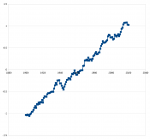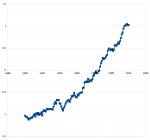winnie
Senior Member
- Location
- Springfield, MA, USA
- Occupation
- Electric motor research
The atmosphere exchange in CO2 is about 750 Gigatons per year. Man-made emissions are about 36 Gigatons per year. Yeah, 5% is not exactly a game changer, and over the last 20 years or so there has been a huge "greening up" of the biosphere. NASA article here. Keep in mind that no one really knows what the true bioexchange rate is. Keep in mind also that the oceans contain another 55,000 Gigatons of CO2.
As I understand it, the background CO2 sequestration is about 1% of the net exchange, and human emissions are about 4% of the exchange, in line with your 5% number. Net result is that atmospheric CO2 is going up a bit every year rather than going down a bit every year.
The problem is, the electrons don't care if the load they serve is dispatchable or not. How do you tell "wind" electrons to go to the dispatchable load? Do you intend to construct an entire parallel grid?
No, everything uses the same grid, but dispatchable loads get _turned off_ to balance loss of renewable generation. You don't need constant loading, you need loading that matches generation. Not trivial, but not impossible.
I can't find anywhere in the LCOE calculations that they accounted for the different life spans of the capital assets. And you can't ignore storage costs. Run the exercise in my post #10.
I saw that the LCOE analysis linked in the Forbes article included the expected lifetime of the generation assets. If you want dispatchable energy, it did _not_ include energy storage costs. IMHO electricity from wind at $36 per MWh is worth less than electricity from a dispatchable source; I like being able to turn the lights on when I want light. Not going to run the calculation in post #10; I've run similar in the past and agree with the basic point: energy storage is expensive.
-Jon






